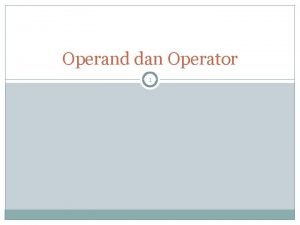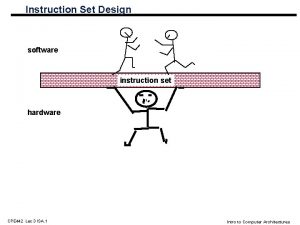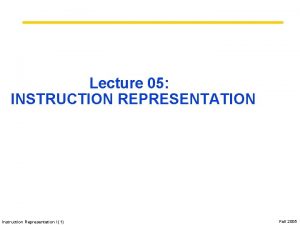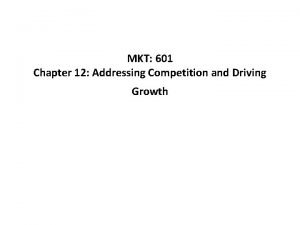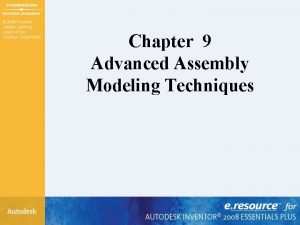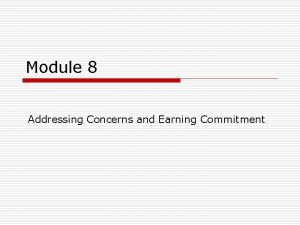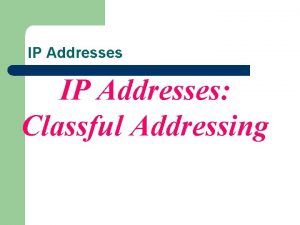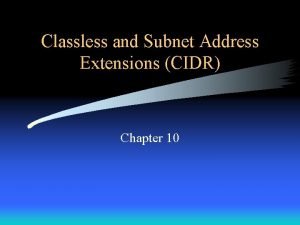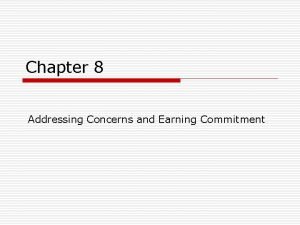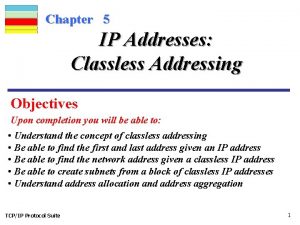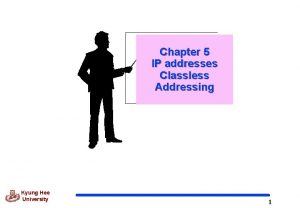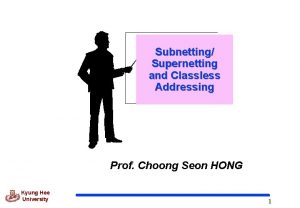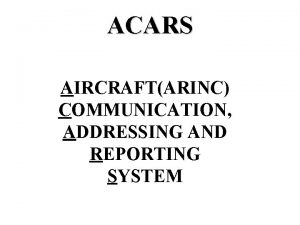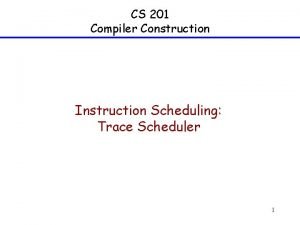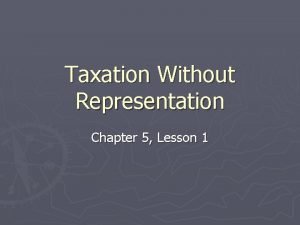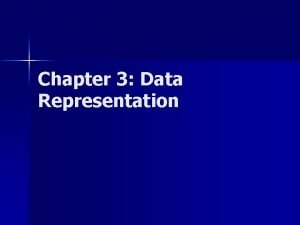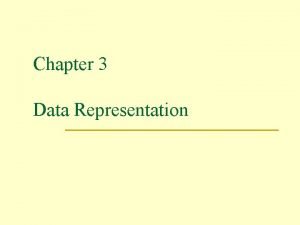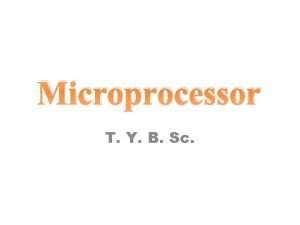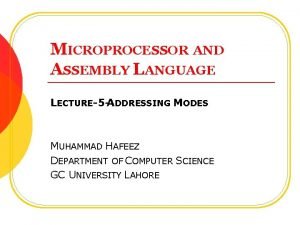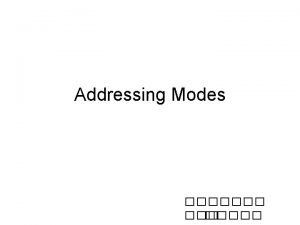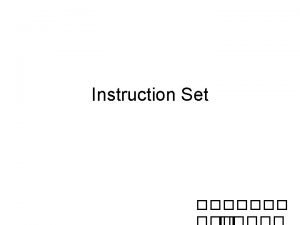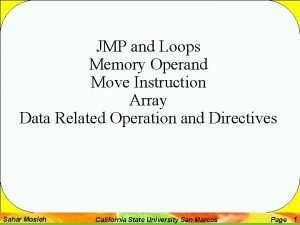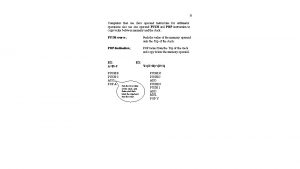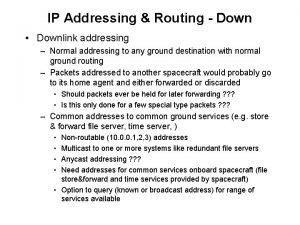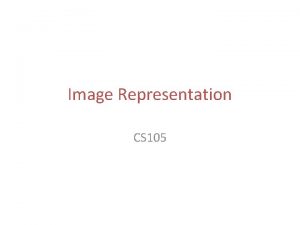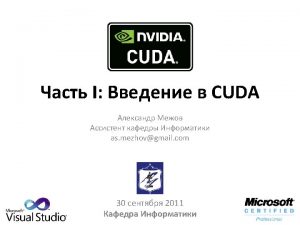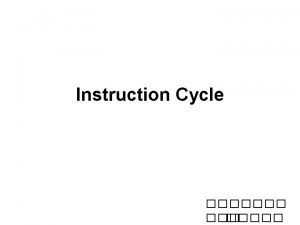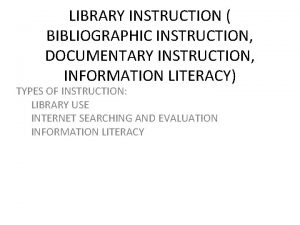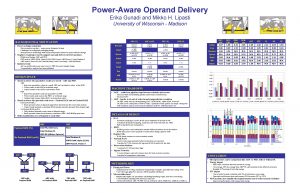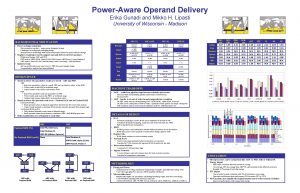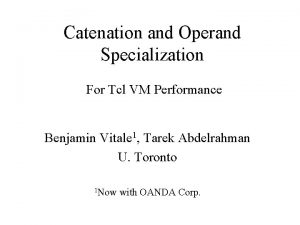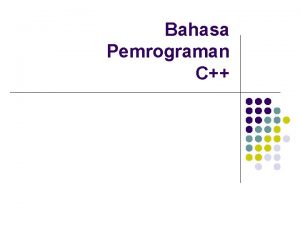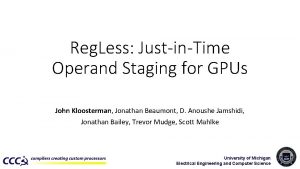Operand Addressing And Instruction Representation Chapter 6 Design





























- Slides: 29

Operand Addressing And Instruction Representation Chapter 6

Design Issues A good ISA Ease of implementing on current hardware Provide clean target for compile code Choice of the number of operands in the instruction set is a matter of discussion.

Zero Operand Instructions Zero address architecture machines are called as the stack machines. The Instruction does not specify any operands. Operands are implicit. Push adds a given node to the top of the stack. Pop removes current top node of the stack and places it in the memory. Based on the Last in first out principle.

From Essentials of Computer Architecture by Douglas E. Comer. ISBN 0131491792. © 2005 Pearson Education, Inc. All rights

One Operand Instruction Architecture that limit each instruction to single operand is known as 1 -address design. Relies on implicit operand for each instruction to store in special register known as an accumulator.

Step to process one operand per Instruction Processor extracts the current value of the accumulator. Performs the specified operation using the extracted value and the operand. place the result back in the accumulator Ex: Add X Accumulator + X

From Essentials of Computer Architecture by Douglas E. Comer. ISBN 0131491792. © 2005 Pearson Education, Inc. All rights

Disadvantage of One Operand Per Instruction It does not allow instructions to specify two values. It requires two instructions that load the value into the accumulator and then need to store the values back in the new location

Two Operand Per Instruction Overcomes the limitation 1 -address systems Using 2 address process, an operation can be applied to a specified value. It also offers data movement instructions that treat the operand as source and destination. Ex: Move Q R Copies directly from Q to R

From Essentials of Computer Architecture by Douglas E. Comer. ISBN 0131491792. © 2005 Pearson Education, Inc. All rights

Three Operand Per Instruction Similar as Two Operand Per Instruction except that it can operate three input value per instruction. For processors which have multiple general purpose registers. Ex: Add X Y Z Computes Z X+Y

Operand Sources And Immediate Values Operand that specifies a source must be -A signed constant -An Unsigned constant -The content of a register -The value in a memory location

Operand Sources And Immediate Values Operand the specifies a destination must be: -A signed register -A pair of contiguous registers -A memory location

Von Neumann Bottleneck Operand addressing is the central weakness of a von Neumann architecture. memory access may become a bottleneck because instructions are stored in memory and a processor must make at least one memory per instruction. To Optimize the performance, operand must be taken from a register instead of memory.

Types of Encoding 1. Explicit Operand Encoding 2. Implicit Operand Encoding

The Opcode specifies the types of operands. A processor that uses a implicit encoding contains multiple operand code for a given operation.

Disadvantage of Implicit encoding Multiple opcodes are needed for a given operation. A list of opcodes can become large, when a processor allows many types of operands.

Explicit Encoding Using Explicit can overcome the disadvantage of implicit encoding. Each operand is represented by two fields: 1. Type of Operand 2. Type of Value

From Essentials of Computer Architecture by Douglas E. Comer. ISBN 0131491792. © 2005 Pearson Education, Inc. All rights

Tradeoffs in the choice of operands Ease of Programming Fewer Instructions Smaller Instructions Larger Range of Immediate Values Faster Operand Fetch and Decode Decreased Hardware size

Tradeoffs in the choice of operands 1. Ease of Programming : We know that complex forms of operands make programming easier 3 -address approach mean we do not need to code separate instructions. 2. Fewer Instructions : Reduces the number of instruction in a program by increasing the expressive power of operands Lowers the count of instructions by increasing the number of addresses Disadvantage 1 & 2: makes the instruction size large

Tradeoffs in the choice of operands 3. Smaller Instructions : How to keep smaller Instruction? Limiting the number of operands Limiting the set of operands types Limiting maximum size of an operand keep instruction small Disadvantage: increases the number of instructions needed

Tradeoffs in the choice of operands 4. Larger Range of Immediate values : Increasing the size allows larger values because the size of a field in the operand determines the numeric range of immediate values. Disadvantage: Larger instruction results

Tradeoffs in the choice of operands 5. Faster Operand Fetch and Decode : How to operate hardware faster? • limit the number of operands • limit the possible types of each operand 6. Decreased Hardware size : How to decrease the hardware size? • limits the types and complexity of operands • Reduces the size of circuitry

Values in Memory Every processors include at least one instruction that allows an operand to specify value in memory Values in the operand interpreted as an memory address. This memory address is for the processor to perform memory lookup.

Advantage of memory look up Helps ease programming Helps allowing arbitrary instruction to reference memory. improves performance.

Operand Addressing Modes Instruction register is used to hold an instruction that is being decoded. A immediate value can be found in instruction register

From Essentials of Computer Architecture by Douglas E. Comer. ISBN 0131491792. © 2005 Pearson Education, Inc. All rights

Key Points Different type of Operand instruction Von Neumann Bottleneck. Different choice of Operand Addressing Modes
 Flat addressing vs hierarchical addressing
Flat addressing vs hierarchical addressing Call by address in c
Call by address in c Contoh operand
Contoh operand Operand fetch
Operand fetch Operand #0 does not dominate this use
Operand #0 does not dominate this use Instruction representation
Instruction representation Individualized instruction vs differentiated instruction
Individualized instruction vs differentiated instruction Site:slidetodoc.com
Site:slidetodoc.com Copyright
Copyright Addressing competition and driving growth
Addressing competition and driving growth The current design view representation is locked
The current design view representation is locked Addressing concerns and earning commitment
Addressing concerns and earning commitment Classful addressing scheme
Classful addressing scheme Classless subnetting
Classless subnetting Earning commitment
Earning commitment Difference between classful and classless addressing
Difference between classful and classless addressing Classless addressing example
Classless addressing example Subnetting supernetting and classless addressing
Subnetting supernetting and classless addressing Acars format
Acars format Trace scheduling
Trace scheduling Chapter 5 lesson 1 no taxation without representation
Chapter 5 lesson 1 no taxation without representation Chapter 5 lesson 1 no taxation without representation
Chapter 5 lesson 1 no taxation without representation Chapter 3 data representation
Chapter 3 data representation Chapter 3 data representation
Chapter 3 data representation Addressing modes of 8086 microprocessor
Addressing modes of 8086 microprocessor Addressing modes of 8086 microprocessor
Addressing modes of 8086 microprocessor Addressing dyslexia toolkit
Addressing dyslexia toolkit Absolute addressing mode in computer architecture
Absolute addressing mode in computer architecture Immediate addressing mode in assembly language
Immediate addressing mode in assembly language Addressing mode in assembly language
Addressing mode in assembly language


